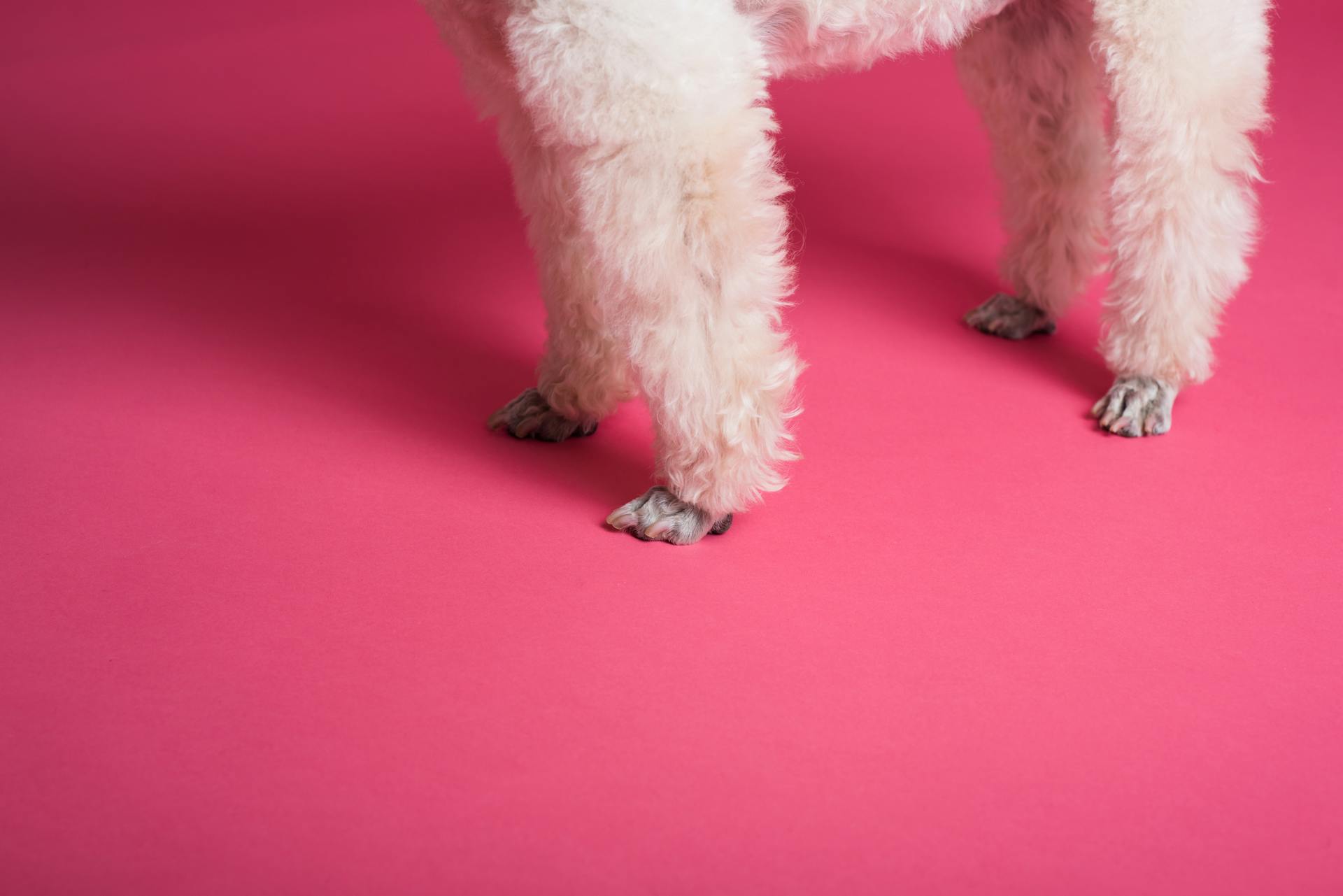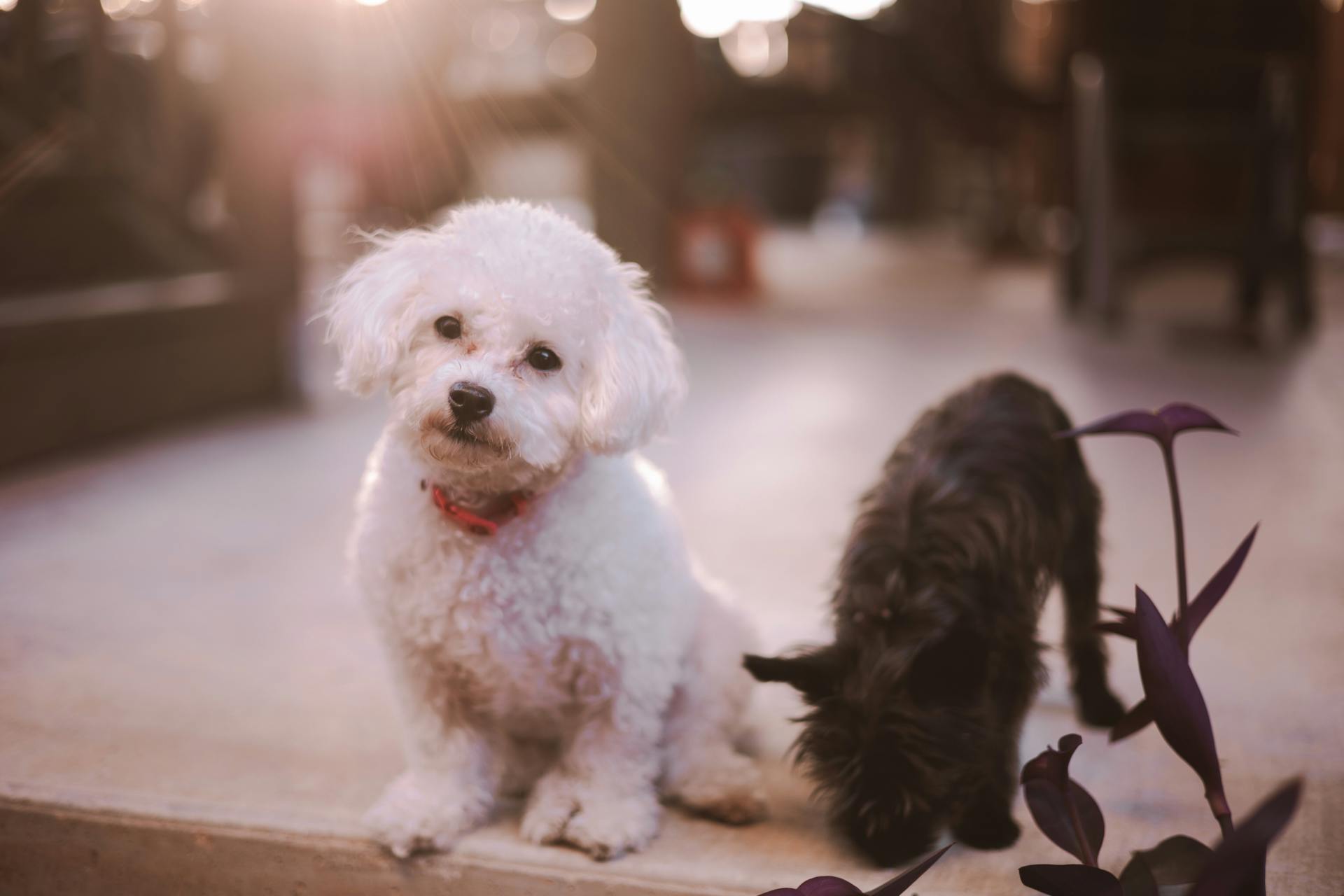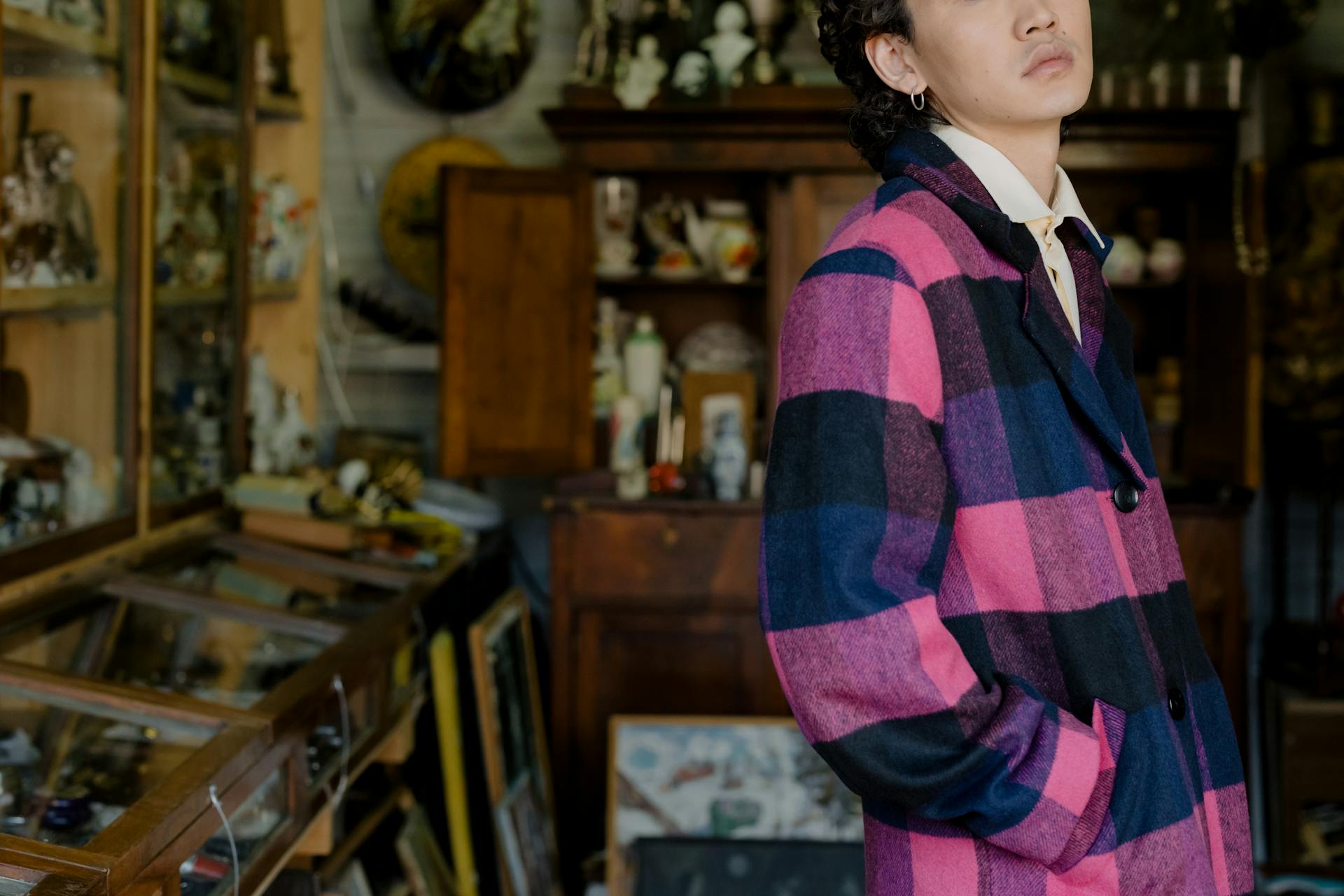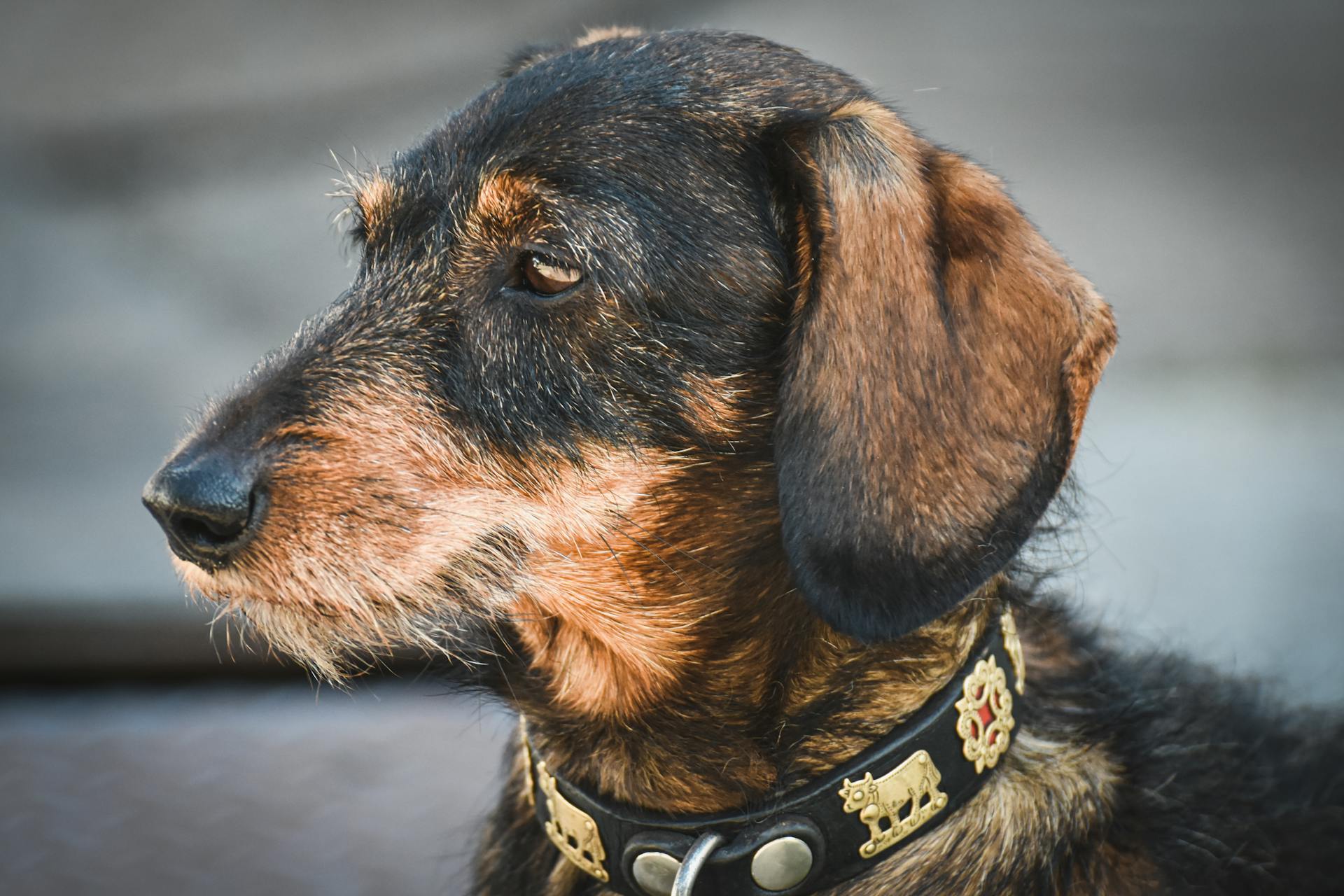
Food colouring is a common additive found in many human foods, but did you know that it can also be present in dog treats and even some dog foods? Some dog owners might be concerned about the safety of food colouring for their furry friends.
The good news is that most food colouring is generally considered safe for dogs in small amounts. However, it's essential to note that some dogs may be more sensitive to colouring than others.
Some colours, like Red 40, have been linked to potential health issues in dogs, including allergic reactions and hyperactivity. In fact, a study found that dogs exposed to Red 40 were more likely to exhibit behavioral problems.
If you're a dog owner who wants to minimize your pet's exposure to food colouring, consider choosing dog treats and foods that are labeled as "colour-free" or "natural."
You might enjoy: Nudges Dog Treats Healthy
A Brief History of Additives and Their Regulations
For thousands of years, humans have been experimenting with additives to preserve food and improve its flavor and appearance. The practice of using spices to prevent food spoilage dates back to at least 3000 BC.
In the 1800s, people started becoming more creative with their additives, turning to chemicals and heavy metals like arsenic and mercury to make foods more vibrant. Sadly, many people died from the unregulated use of these toxic substances.
The US government passed the Pure Food and Drugs Act in 1906, which aimed to protect consumers from dangerous products, including some of the artificial food dyes already on the market. This bill outlined acceptable manufacturing practices and sanitation measures and made harmful ingredients unlawful.
Since the 1960s, the Food and Drug Administration has banned more than 25 food color additives. The artificial dyes that remain are held to strict regulations regarding their usage.
Most true food allergies in pets are due to food proteins, which food dye doesn't contain. This is a crucial distinction when considering whether food coloring is safe for dogs.
The FDA approves only certain synthetic food colorings for use in foods, including:
- FD&C Blue No. 1
- FD&C Blue No. 2
- FD&C Green No. 3
- Orange B
- Citrus Red No. 2
- FD&C Red No. 3
- FD&C Red No. 40
- FD&C Yellow No. 5
- FD&C Yellow No. 6
Types of Food Colouring
The FDA has approved nine synthetic dyes for use in food, including pet food, which are derived from petroleum. These dyes are commonly used in pet food due to their bright tones and stability.
The most commonly used synthetic dyes are FD&C Blue 1, Blue 2, Green 3, Red 3, Red 40, Yellow 5, and Yellow 6. They are cheaper than natural alternatives.
Red, yellow, and black iron oxides, also known as rust, are FDA-approved for some uses in pet food. However, some studies have shown that iron oxide can cause skin and eye irritation, and inhalation can lead to lung inflammation in rats.
Artificial food dyes have zero nutritional benefit and are toxic in some degree, whether contaminated, carcinogenic, allergenic, or genotoxic. Some dyes may have cancer-causing effects or trigger allergic reactions.
On the other hand, natural colorings like annatto, made from seeds of the achiote tree, are widely used in cooking and cosmetics and are generally safe for dogs.
You might enjoy: Vet Approved Homemade Dog Food Recipes for Large Dogs
Research and Safety
The FDA classifies artificial food dyes as "generally safe to use", but several independent studies have found links to hyperactivity, allergic reactions, and even cancer in humans.
Most research on food dye safety involves lab rats, with little data on dye-related allergic reactions in pets specifically. However, studies show that Red #40 and Yellow #5 and #6 can cause hypersensitivity and cell damage in small mammals.
The FDA allows trace amounts of known carcinogens in dyes Red #40 and Yellow #5 and #6, but experts say that food dye does not influence the body's ability to metabolize food.
Red #3 is another concerning food additive, linked to thyroid cancer, and the FDA recognizes it as a carcinogen, yet it's still allowed in food and oral medications.
Proteins in dog food are the most common allergens in dogs that experience food-related allergic reactions, and food dye doesn't contain these proteins.
What About "Natural"?
Even natural food coloring can be problematic for your dog. Annatto, a natural coloring made from seeds of the achiote tree, can trigger food intolerances or irritable bowel syndrome in some dogs.

Natural colorings like paprika, beet juice, and turmeric are gaining acceptance, but they may be more costly than synthetic dyes. These colorings are generally safe for your dog, but it's essential to monitor your dog's sensitivity.
Carmine, a natural red dye derived from crushed female beetles, can trigger reactions in dogs allergic to insect proteins. This is a significant concern, as carmine is often used in natural food coloring.
Natural food coloring can be heavily processed or altered, making it just as synthetic as artificial dyes. For example, caramel color, derived from corn syrup, can create carcinogenic by-products when processed with ammonium.
It's essential to consider the potential risks of natural food coloring before feeding your dog foods or treats with these ingredients.
A Closer Look at the Research
Studies have investigated food dye safety in humans, but the results are mixed. Several independent studies have linked 4 common artificial dyes to hyperactivity, allergic reactions, and even cancer in humans.

The FDA classifies artificial food dyes as "generally safe to use" for humans, but this doesn't necessarily mean they're safe for pets. Most research on food dye safety involves lab rats, not dogs and cats.
Lab rats have shown hypersensitivity and cell damage from Red #40 and Yellow #5 and #6. These dyes can cause hyperactivity in children and adolescents, and even affect brain chemistry and learning in high doses.
Red #3 has been linked to thyroid cancer in studies, and the FDA recognizes it as a carcinogen. Despite this, the FDA still allows Red #3 in food and oral medications.
The FDA allows trace amounts of known carcinogens in dyes Red #40 and Yellow #5 and #6, as long as they're within a certain percentage of the total volume.
If this caught your attention, see: Lab Dog Black Colour
FDA and Approval
The FDA plays a crucial role in regulating food coloring for dogs. The FDA reviews the risks of artificial food coloring ingredients and has banned dozens of synthetic dyes due to their toxicity or side effects.
The FDA currently certifies nine synthetic dyes, including FD&C Blue 1, Blue 2, Green 3, Red 3, Red 40, Yellow 5, and Yellow 6, which are all derived from petroleum. These dyes are widely used in pet food due to their bright tones and stability in products.
While the FDA considers these approved dyes safe, it's a controversial topic, and some are banned in other countries. One well-known side effect of artificial food colorings is hyperactivity in children.
The FDA justifies the approval of these compounds by pointing out that there aren't studies conclusively proving these dyes are bad for dogs, specifically. However, there are studies linking these synthetic dyes to health issues in both humans and rodents.
The FDA-approved artificial food coloring agents follow strict regulations regarding their usage, including how much dye manufacturers can use and which products they can be used in.
Discover more: Blue Buffalo Dog Food Killing Dogs
Risks and Precautions
Synthetic food colorings in dog food can cause hypersensitivity and cell damage in small mammals, including dogs. Studies have shown that exposure to high doses of Red #40 can result in changes in brain chemistry and learning and memory issues.
Red #40, Yellow #5, and Yellow #6 have been linked to hyperactivity in children and adolescents, and animal studies have found that they can cause cell damage. Independent studies have also found trace amounts of known carcinogens in these dyes.
If your dog has eaten something with food coloring in it and you're worried about their health, it's best to consult a vet.
Is Safe?
The FDA considers artificial food dyes "generally safe to use" in pet food.
While food dye may not influence the body's ability to metabolize food, experts say it's still worth being cautious.
Purina, a major pet food manufacturer, states that very little artificial dye is needed to achieve the desired color of food.
You should always consult with your vet before switching your pet's food, as abrupt changes can cause stomach upset.
If you're concerned about artificial food dyes, you can opt for pet food that uses natural dye instead.
Risks of Eating Certain Foods

Some foods can pose serious risks to our furry friends.
Red #40, Yellow #5, and Yellow #6 are synthetic compounds commonly found in food and cosmetics, but they can cause hypersensitivity and cell damage in small mammals.
These artificial colorings can lead to hyperactivity in children and adolescents, and animal studies have shown that high doses of Red #40 can result in changes in brain chemistry and learning and memory issues.
Trace amounts of known carcinogens have been found in dyes Red #40 and Yellow #5 and #6, which are allowed by the FDA as long as they're within a certain percentage of the total volume.
Blue 2, another synthetic dye, has been linked to brain tumors in rats during testing.
It's worth noting that these colorings are widely used in American dog food and treats, even though they're completely legal.
Frequently Asked Questions
What happens if dogs eat food dye?
Dogs eating food dye may be linked to cancer, cell damage, and changes in brain chemistry. Fortunately, many pet food brands now use natural coloring agents like carrots and turmeric instead of synthetic dyes.
Can you put food coloring in dog cake?
No, it's not recommended to add food coloring to dog cake due to potential allergic reactions. Consult our guidelines for safe and healthy dog treats
Sources
- https://wagwalking.com/wellness/food-coloring-in-pet-food-what-you-need-to-know
- https://www.dogsnaturallymagazine.com/is-food-coloring-safe-for-dogs/
- https://www.dogster.com/dog-nutrition/can-dogs-have-food-coloring
- https://naturesadv.com/blogs/natures-blog/is-food-coloring-safe-for-dogs
- https://www.dogster.com/dog-nutrition/is-food-coloring-safe-for-dogs
Featured Images: pexels.com


